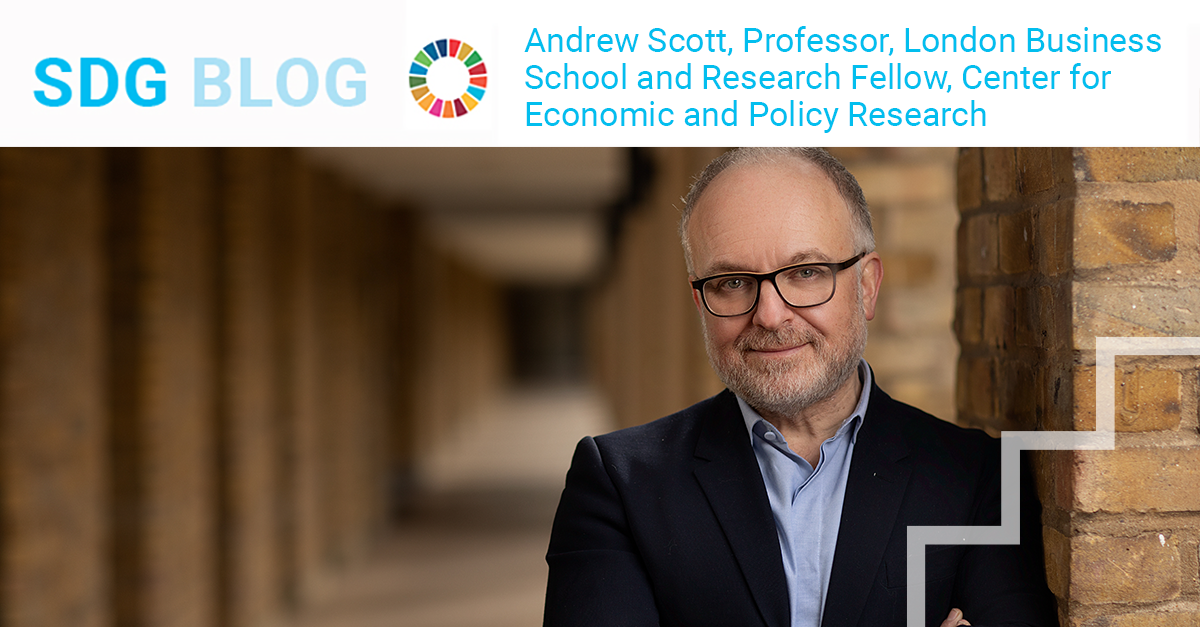SDG Blog

The Sustainable Development Goals and a Longevity Agenda
By Professor Andrew Scott, Department of Economics, London Business School and Research Fellow, Center for Economic and Policy Research
The world population has reached 8 billion, a fourfold increase since the early 20th century. Achieving long-run prosperity for all in the face of this increase has been a motivating force for the UN’s Sustainable Development Goals.
This 8 billion landmark marks a time of change for demographic trends. Population growth is expected to slow as declining fertility rates offset the impact of higher life expectancy. A number of countries are projected to see declining populations. Japan, for instance, is expected to end the 21st century with a population of 74 million, down from its 2010 peak of 128 million.
As population growth declines, changes in the population structure will become more important. Declining fertility rates and growing life expectancy are leading to a rising proportion of older people and fewer children – an ‘ageing society’. For the first time, those aged over 65 years exceed the number aged under 5. By 2050 they will outnumber the under 10s, and by 2100, the under 21s.
As reflected in the 2002 Madrid International Plan of Action on Ageing, this shifting age structure requires shifting behaviours and policies if the Sustainable Development Goals are to be met. At the very least, this growing proportion of older people requires a greater share of resources. It is also essential to recognise that with two-thirds of those aged over 65 years living in low- and middle-income countries this is a global priority.
The prospect of an ageing society is often seen as a negative, with concerns of declining economic growth and public finance pressures. This negativity is a strange way to view one of the greatest of human achievements. An ageing society means mourning fewer infant deaths, fewer parents snatched away in midlife, and more grandparents meeting their grandchildren.
One reason for this negativity is that an ageing society emphasises changes in the population’s age structure rather than changes in how we age. The latter is required because of remarkable increases in global life expectancy, which now stands at 73 years. That has the radical implication that the probability of the young becoming old has never been so high. That requires fundamental changes in the life course, reflecting the fact that everyone, regardless of age, now has more years ahead of them and so has to invest more in their future.
What an ageing society and increased longevity both demand is that individuals and society do not underestimate the capacity of later years. With more of our lives being spent at older ages and more of the population consisting of older people, it is crucial that we do not underestimate their potential or, through lack of investment, fail to realise it. A three-dimensional longevity dividend needs to be targeted – as lives become longer, they also must be healthier and productive for longer.
This focus on adapting to longer lives has important implications. The first is a significant change in health challenges. Increasingly age-related non-communicable diseases are the most important cause of death and disease globally. Tackling these requires a shift towards preventative health and focusing on maintaining health rather than treating disease.
The second is to recognise that healthy ageing isn’t only about the needs of the current older population. It is also about ensuring that the current young become the healthiest ever generation of older people. To avoid intergenerational tensions, it is essential to recognise that the need to adapt to longer lives affects young and old alike.
This links to a third implication. Too often, the demands of an ageing society are mistakenly seen as a priority only for high-income countries. Currently, South Africa and India have only 6% and 7% of their population aged over 65, but by 2085 these will be 17% and 24% respectively – similar to Germany and the United States today. Those 65-year-olds in 2085 are currently infants. Healthy ageing requires supporting people when they are young and not just when they are old.
A final implication is to recognise the substantial contribution older people already make to society and the economy – through caring, community roles, and employment. Given the growing likelihood of the young becoming the old, greater investment needs to be made in health and skills to support working and being engaged for longer. All past health and education improvements have benefited the economy, and the same should hold for improvements at older years.
Because of these shifting demographic trends, achieving the Sustainable Development Goals will increasingly be about supporting adaptations to longer lives. Individually and collectively, we need to avoid underestimating the capacity of these later years and ensure that they are healthy, productive and engaged ones for all.
* The views expressed in this blog are the author’s and do not necessarily reflect the opinion of UN DESA.
 Welcome to the United Nations
Welcome to the United Nations